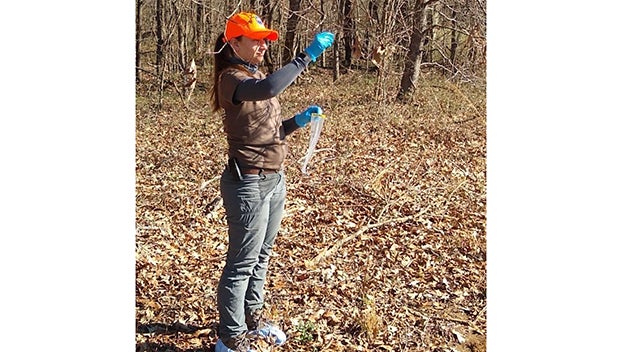CWD positive detection in Southwest Mississippi supports MSU Deer Lab research
Published 12:29 pm Wednesday, February 7, 2024

- Miranda Huang clips a branch as she collects samples for a project looking to see if CWD could be detected in scrapes and used to survey for the disease. Her work found a CWD prion in Claiborne County which was reported to the MDWFP in June. (Submitted Photo | Miranda Huang)
PORT GIBSON — Mississippi Department of Wildlife, Fisheries and Parks reported a positive detection of Chronic Wasting Disease in Claiborne County Wednesday morning. According to the CWD dashboard, it is one of six new positives to come in today. The detection supports ongoing research at Mississippi State University’s Deer Lab.
MDWFP’s dashboard map shows the positive was detected west of Port Gibson about three miles from the boundary line of the Mississippi River and about 10 miles from positives in Tensas Parish in a bend on the Bayou Pierre. Chronic Wasting Disease is caused by an infectious prion and is a 100 percent always fatal disease in the cervidae family threatening Mississippi’s deer herd.
Mississippi’s other five CWD detections came in DeSoto County, Benton County and Marshall County. MDWFP reported a season record in CWD positives was reached in January. Per Mississippi’s CWD Management plan, the Claiborne County positive is considered a suspect positive until it is confirmed by a national laboratory.
MDWFP Deer Program Coordinator William McKinley said the positive was detected close to a scrape where CWD prions were found in a research project conducted by MSU.
“The scrape was sampled one year ago this month,” McKinley said. “It shows environmental sampling can help us determine where the disease is likely present prior to the detection of a positive deer. It supports the research being done at MSU.”
Hunters should sample deer for CWD to aid the MDWFP in determining the disease’s prevalence in Claiborne County and survey for the disease in other low sampled counties in Southwest Mississippi. Canemount WMA and All Creatures Veterinary Hospital in Port Gibson have self serve drop off coolers for samples.
Anyone who killed a deer in Claiborne County this year could still submit a sample if they have the head and lymph nodes attached. As long as the lymph nodes have not decomposed they can be sampled for CWD.





